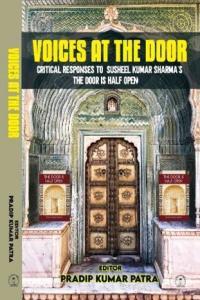Creation and Criticism
ISSN: 2455-9687
(A Quarterly International Peer-reviewed Refereed e-Journal
Devoted to English Language and Literature)
Vol. 08, Joint Issue 28 & 29: Jan-April 2023

Critique
Voices at the Door: A Sensitive Journey of the Poet
Dharmendra Kumar Singh
Voices at the Door by Pradip Kumar Patra is a compendium of critical responses to Susheel Kumar Sharma’s second anthology of poetry, titled, The Door is Half Open (2012). Encompassing 57 reviews by bright scholars and academicians from India and abroad, together with a preface, an introduction, and an interview between the poet (S. K. Sharma) and the editor (P. K. Patra), it came to light in 2023. It is dedicated to Prof. Brahma Dutta Sharma, the unassuming erudite scholar, and Prof. Prafulla C Kar, the untiring scholar, trainer, and institution builder. It has astounded scholars, and the world has rolled out the red carpet for it. It does not stop here. It openly gives serendipity to the reviewers to roll out their priceless thoughts.
As a reviewer, I could not keep myself away from reviewing the reviews of all those scholars and academicians who have moved their pen on Sharma’s second collection of poems. The first thing that agitated me more and more to put my fingers on the key (board) is the title of both books—Voices at the Door and The Door is Half Open. The former book is the one through which I tried to open the half-open door of the latter book. At the same moment, it reminded me the optimistic raga of the Indian sages who would often see activity in passivity, possibility in impossibility, positivity in negativity, and life in death. It did not paused here. Additionally, it prompted me to Milton’s idiomatic expression “Every cloud has a silver lining,” and Shelley’s “If winter comes, can spring be far behind?” blah-blah-blah. I became beguilingly helpless. I was hypnotized, without mincing any word as I say here, in such a way that I could not know when Voices at the door pushed me by stealth into The Door is Half Open. And what reviews I found there are no less than such gems that made Sharma’s rosary more radiant.
Where Abha Iyengar’s “Falling Brick by Brick” highlights S. K. Sharma’s capability of handling the light both inward to examine the being and outward to examine the world in Indian milieus, where Ann Rogers’s “Sympathetic Understanding of a Sensitive Journey” acmes Sharma’s sensitive dealing with grief, poverty, and struggle, where Ashok Kumar Sinha’s “Recreation of Modern Man’s Thoughts” calls attention to Sharma’s power of providing snapshots of the trials and tribulations of the modern man, where bilingual poet and translator Awadhesh Kumar Sinha’s “Problems of a Pilgrim” focuses attention on Sharma’s power of underscoring the spirituality through his creativity, where Barbara Wühr’s “Soul and Roots in India” spotlights on Sharma’s competent soul connected with India, where Carol Abrahms’s “The Door of Life” foregrounds Sharma’s picturesque might, where G. L. Gautam’s “Of Religion and Suffering” weighs Sharma’s poetic capacity in the terms of Marxian critique of religion, where Gagana B Purohit’s “The Postcolonial Concerns” presents Sharma’s vigour of pointing up the postcolonial representation of roots, identity, and a unique and cosmopolitan culture locating the essence of cultures placed side by to practice a kind of alternative modernity, where Gavriel Navarro’s “Engaging Wit and Touching Familiarity” demarcates Sharma’s potency of touching familiarity wittingly, where Georgia Eva Xanthopoulos’s “Emotional Enlightenment” plays up Shama’s brawn of encompassing enlightenment and emotions through poetic allure, where Gurrapu Damodar’s “Well Chiselled Poetry” praises Sharma for deserving encomiums for wide-ranging themes dealing with life in general and life in particular, where H. C. Gupta’s “Conscious Flow of Ideas” portrays Sharma’s confessionality, autobiographicality, and devotionality, where Jai Shankar Jha’s “Quintessentially Indian” reviews Sharma as the embracer of multiple facets of life including cultural, social, personal, emotional, political, and spiritual aspects, where Jasvinder Singh’s “A Peep into the Realms of Life” reports Sharma’s poetic offerings of the various nuances and vibes of life, where Jordan Clary’s “Of the River Ganges and Other Sacred Things” projects the sacredness of Sharma’s chant-like poem “Ganga Mata”, there Jyotsna Prabhakar’s “Performative Creative Imagination” ventures Sharma’s triggering supremacy to his creative imagination, there K. Balachandran’s “Of Man’s Ways” schemes Sharma’s interrogation of mending man’s ways, there KK Mishra’s “Simple and Lucid Poetry” makes an assessment of Sharma’s command over language and lucidity in expression, there K. Rajamouly’s “Poetry for Reform” acclaims Sharma’s poetry for being a medium and spectrum of aimed reform and desired solution, there Kamala K’s “The Ganges Continues to Flow” assumes the Ganges as the fountainhead of Sharma’s creativity, there Kenneth Lumpkin’s “Honest Poetry in Magician’s Language” displays Sharma’s power of blending native Hindu culture honestly with his newer Anglo one writing good and honest poetry in a foreign language, there Krishna Gopal Srivastava’s “Wholesomely Experimental Poetry” makes a parade of Sharma’s talented individualistic response, there Kulwant Singh Gill’s “Images with Stings in the Tails” hails Sharma’s mincing of swarm of images that are sweet, sour, and sublime, there Leela Kanal’s “Nostalgia for Simplicity and Values” spots Sharma’s sense of nostalgia for the simplicity, the values of the past, and a spiritual yearning for a return of the old glory of Bharata, there M.R. Joshi’s “Poems of Splendid Imagination” praises Sharma’s handling of impressive Indian imaginations, there Madhumita Ghosh’ “Exploring a Treasure” analyses Sharma’s burliness of handling the mysterious Indian gems, there Mary Mohanty’s “Nostalgia for Glorious Past” diagnoses Sharma’s craving for Indian knowledge, mythology, religion, culture, ethos, and his belief in the human and spiritual values in the midst of the inhuman world, there Mithilesh Kumar Pandey and Shankhadeep Chattopadhyay’s “Self-Exploration through Empathetic Imagery” x-rays Sharma’s welly of fashioning self-exploration through romantic imageries, there Maxim Demchenko’s “Doors of Perception” accentuates Sharma’s thew of bestowing the philosophical doors of acuity metaphorically, there Mohan Patnaik’s “Tremendous Humanism” appraises Sharma’s power of representing incredible humanism, there N.N. Monachari’s “Dominated by the Sounds of the L1” analyzes Sharma’s eloquence of dealing with what most of the Indian English poets probably miss, there N.S. Sahu’s “An Uncritical Critique” spots Sharma’s cogency in offering candid commentaries on the sleazy actualities of life in a state-run of gaudy sensation.
Where Neerja Arun’s “Amazingly Intricate and Intimate” commends Prof. S. K. Sharma’s potentiality of hafting intricate and intimate approaches of life in the versification of the congregation The Door is Half Open, where Nikunj Kishor Das’s “Scintillating Poetic Fount” highpoints Sharma’s power of pouring solemn thoughts through enjoyable aesthetic pleasure, where P C K Prem’s “A Journey Inside” climaxes Sharma’s persuasiveness of bestowing his solitude to extract presumed nectar in drops out of transitory meditation in anarchic times, where Patricia Prime’s “Lively Encounters with Life and Language” illustrates Sharma’s authoritativeness of portraying exuberant, dynamic happenstances with life and language related to past and present, where Pradip Kumar Patra’s “Intense and Pure Poetry” manoeuvres Sharma’s intensity of griping primeval perception and recent susceptibility, where Pragya Mishra’s “Exploring the Hidden, Unexplored and Unnoticed” dashes Sharma’s brawniness of viewing the various flavours of earthly existence, where Prakash Chandra Pradhan’s “Socio-Cultural Ethos of India” detects Sharma’s brio of representing the socio-cultural ethos of India with a deep sense of grief of the poetic self for the suffering of the less privileged, where Pritam Bhattacharyya’s “A Reading Experience” assesses the fine honesty of Sharma’s this anthology of poetry, where Rabindra Kumar Verma’s “Thought Provoking Indian Sensibility” sights Sharma’ synergy of aggravating Indian sensibility considerately, where Radhika P. Menon’s “A Roller-Coaster Experience” perceives Sharma’s competency of bringing such experiences to the fore of the readers that give gothic excitement inviting them into different swiftly changing facets of internal and external world, where Rashmi Jain’s “Postmodern Poetry” witnesses Sharma’s resilience of lettering harsh realities of life, including casualness of life and bonds in life, where Reena Sanasam’s “Of Tradition, Nostalgia, and Spiritualism” pronounces Sharma’s valour of making confluence of tradition, nostalgia, and spiritualism, where Ritika Singh’s “Myriads of Experiences” points out Sharma’s aptitude and attitude of delineating the personal, public, and social insights that offer a myriad of experiences to the readers, where Roy Robert De Vos’s “Honest Assessment of Life” sizes up Sharma’s personal odyssey of beseeching lament at the current state of India, there Sandeep Kumar Gupta’s “Confessional, Autobiographical and Devotional Poetry” through the confessional devotionality of autobiographical glimpses transcripts Sharma’s efficacy of propounding the material comfort and a treasury of the English speaking world that epitomizes a necessity, there feminist author Shamenaz Bano’s “Revering the Environment” puts down Sharma’s power of producing pleasure by just expressions of imaginative thoughts and feelings in metrical language, there Shanti Rajaraman’s “Be Your Own Buddha” evaluates Sharma’s skill of unleashing the ancient power of India and looking at it as divine, there Shubha Dwivedi’s “Journey of Self-Realization” reconnoitres Sharma’s poetic itinerary which culminates his poetic and spiritual realization, there Stuti Khare’s “From Emotional Exploration to Light-Hearted Banter” scouts Sharma’s dexterity of capturing different moods ranging from intense emotional exploration to light-hearted banter, from discursive and descriptive to reflective compositions in verse, there Sudhir K. Arora’s “Unmasking the Masks Unmasks” Sharma’s variegated thematic hues with which he—the poet— gently waits to colour and surprise the readers to the true colour of the reality as the truth, there Suresh Chandra’s “Appraising Indianness via the Foreign” stamps on Sharma as being an unusual and a trend setter, there Suresh Chandra Dubey’s “People’s Poetry” commends Sharma’s aristocratic mind set, there Suresh Chandra Dwivedi’s “Clarification of Life” exhibits Miltonic quality in Sharma’s poetry, there Syed Ahmad Raza Abidi’s “Probing the Plurality of Subjective and Objective Voices” esteems Sharma’s supremacy of dealing in concrete terms with concrete experience, there T S Chandra Mouli’s “Life in All Forms and Beyond” compliments Sharma’s poetic consciousness and socio-cultural moorings, there his (Sharma’s) interview with Pradip Patra democratically leaves all for readers and critics who are the two eyes for a poet.
To cut a long story short, what sound I heard on going door after door of the reviewers’ reviews in Patra’s Voices at the Door is that most of them delve into reviewing Sharma’s sensitive journey, which is spiritually rooted in emotional, cognitive, and behavioural enlightenment of ancient and modern India. If one truly wants to perceive the true colours of India, one need not visit it physically; one need not spend money and time; one need not go from port to port, from station to station, or from bus stop to bus stop. One need not take the pain of long drive, and the rest. What one needs is to go through Sharma’s second anthology of poetry The Door is Half Open, where one will have the thought of modern India mosaicked with postcolonial concerns. One will have quintessential India flaked with the ways, pays, and rays of life and light. One will have a creative India brimming with logical gumption and high imagination tantalizing olden golden simplicity and ethics of the bygone days. One will have the doors of perception, scintillating poetic founts along with Indian socio-cultural tenets, thought-provoking Indian sensibilities, and a roller-coaster myriad of experiences. One will have glimpses of the Indian Buddhas revering the environment. This book will gently unmask, as I bet, all the masks about India and its people, its myths and traditions, and its culture and civilization that persistently contour its raga and saga. It will never disappoint its readers. One and all will have the poetry of life clearing its all forms and beyond. Buddha will banter at one who, ignoring this book, plans to visit the country called India at the cost of one’s time, talent, and tiredness. If one wishes to have a better understanding of India, it is better to go through this book, otherwise, Mother Ganges will not liberate one from one’s all ifs and buts at the Ghats of Varanasi. On its banks, none will ever get as what T.S. Eliot uttered-DA, DA, DA.
Work Cited:
Pradip Kumar Patra (ed.). Voices at the Door: Critical Responses to Susheel Kumar Sharma’s The Door is Half Open. Delhi: Upanayan Publications, 2023. Pages: 270. Price: Rs. 599/-. ISBN: 978-93-91467-00-5.
 About the Author:
About the Author:
Dr. Dharmendra Kumar Singh is Assistant Professor of English at MHPG College Moradabad, affiliated to MJPRU Bareilly, U.P., the Republic of Bharat. Creative and critical writing is his passion. He can be contacted at dksinghdharmendra@gmail.com.


